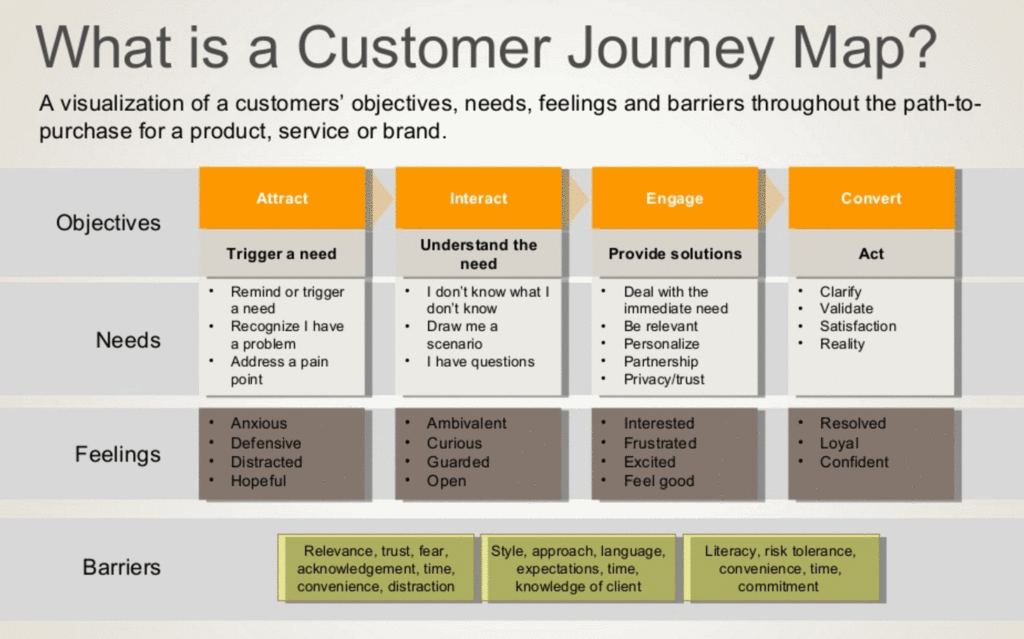In the McKinsey survey of senior executives, 90% respondents feel that customer experience (CX) is one of the top three priorities of the CEOs. In the recent times, startups are disrupting the market, as they have pricing advantage and less complex products compared to large businesses. Enterprises can survive only by embracing CX as a differentiator. The best way to tap CX is through the customer journey map.
How do we define the customer journey map?
If you have customers interacting with your products and services, the experience they have with your brand is customer experience(CX). It’s crucial to capture each touchpoint and weave a customer journey from discovery to sales. The visual diagram representing the journey is called the Customer Journey Map. It helps companies in targeting customers on a highly individual level.

Why is mapping customer journey crucial for eCommerce?
In the digital age, shopping has transformed into digital shopping where new forms of engagement are emerging daily. The digital presence has increased the number of customer touch points for both brands and retailers. The timeline of customer journey starts at brand awareness and engaging customers during the discovery phase. Whenever a customer comes in contact with the brand, there lies an opportunity to engage, which can turn into a purchase.
Recently, post sales experience has also found a place in the customer journey map. Customer’s experience with the product and how they share it with their friends, family, and even strangers, add a lot of returning and new customers to the bucket.
What does a Customer Journey bring to the table?
- It empowers you to identify and understand customer needs in a better way, improving customer service.
- To spot the operational efficiencies and saving the unnecessary expenditure.
- Unearthing opportunities to differentiate products.
- An efficient customer experience results in better customer retention rates and boosts brand reputation.
What do you need to keep in mind for creating a customer journey map?
Before creating your journey map, it’s crucial to define the scope of the journey map, starting with your objectives. It is followed by the most important step in the series, creating customer personas to help you identify your ideal customer. Personas help you in defining the paths that customers will take to purchase your products. This involves interviewing the recent and potential customers about the research they did before making the purchase including competitor sites, how they found your site, experience with your site and what were their motivations to make a purchase decision.
Meanwhile, you also discover their likes, dislikes, preferences, and needs from the present experience. The pain points and challenges will highlight the opportunities to enhance customer experience. These insights can be reused to improve the marketing and communication initiatives for better sales and customer service experience.
The information collected has to be mixed with analytics and competitive intelligence data to get a better understanding of the buyer persona. Finally, it’s time to identify the key touchpoints where your customer is likely to interact with your brand or product.

The stages in eCommerce can be broadly divided into discovery, ordering, shipping, delivery, returns, and refunds. However, there’s a lot happening at each stage that needs to be captured to create a timeline of the customer journey map. You figure out actions, motivations, questions, and barriers during the in-depth ethnographic style interviews, survey, focus groups, and context observations of the customer research.
Actions
What is customer doing at each stage? What are the activities involved and what actions promote them to the next stage?
Motivations
What emotions does customer feel and how those inspire them to move further?
Questions
What are the uncertainties and doubts that require resolution or discussion for customers?
Barriers
What are the serious issues preventing customers from moving to next stage?
Some tips to get the customer journey map right
- You need to use your existing data, whenever possible to reduce the effort on research.
- Research-backed personas help you sketch an extreme user for your product.
- Emotions are critical to the customer journey map, influencing every decision that customer makes.
- You need to capture the time period taken by the customer for each activity, for example, browsing time before reaching a decision or on a customer service call.
- It’s also really good if you can talk to your customers and cover their views in the journey.
- The understanding of the customer facing team and their feedback helps you better identify the gaps between customer expectations and delivery.
Mastering the journey map
The customer journey is nonlinear. Sometimes customer jumps directly from awareness to purchase, if they have a strong recommendation. At other times, the research process can be really prolonged. It’s essential for brands to identify all critical touchpoints by making a map of the entire decision-making process.
You have to study the use cases to create an effective journey map. This involves right from where customers have landed on your journey, and able to align with what they want to accomplish. A perfect journey map is a storyboard with everything supported by photos and sketches of customer interactions. If a consumer is guided with clear communication throughout the journey, across all channels, this results in a consistent customer experience.
